Top>Research>Nano Coordination Chemistry Which Controls Electrons, Protons, and Light
 Index
Index
Nano Coordination Chemistry Which Controls Electrons, Protons, and Light
Masaaki Haga
Professor, Department of Applied Chemistry, Faculty of Science and Engineering, Chuo University
Areas of Specialization: Coordination Chemistry, Molecular Electrochemistry, Surface Chemistry, Nano-Molecular Chemistry
Introduction
When I was a graduate student in the 1970s, Japan experienced two oil shocks and the sense of urgency regarding energy heightened. Around that time, I was shocked when I read a report on an experiment published in the Journal of the American Chemical Society. According to the paper1), water was separated into hydrogen and oxygen when applying a coat of a metal complex containing ruthenium which possesses a long-chain alkyl group to an indium tin oxide (ITO) electrode and then irradiating the electrode with visible light while submerged in water. It was the first time that I felt the excitement of electrochemistry containing metal complexes, light energy, and oxidation-reduction reactions. Although I had previously heard of the Honda-Fujishima effect (photodegradation reaction of water using oxidized titanium electrodes) which was famous around that time, the idea of this reaction occurring with visible light and using complexes was completely new to me. At undergraduate school, I had learned that colored metal ions absorb visible light, but I now realized that ruthenium complexes crated by surrounding metal ions with an organic compound called ligands could transfer electrons between water and electrodes with visible light energy. This is the same photochemical reaction as the photosystem which is performed inside of leaves. Through photosynthesis, the pigment known as chlorophyll captures light and an electron flow is caused by a multi-staged oxidation-reduction reaction. Furthermore, the photosystem is secured to a membrane, and the difference in the environment inside and outside of the membrane causes oxidation-reduction of water which in turn leads to concentration gradient of protons. The paper which I introduced above shows that metal complexes can fulfill the roles of chlorophyll in photosynthesis. If it were possible to use complexes which possess absorbency in the visible light range to control the movement of electrons and protons, interesting research would be possible. Furthermore, similar to semiconductors which use silicon as a base, I am intrigued by the idea that using molecules to control the movement of electrons would enable the creation of a molecular device. While setting such vague orientations for my research and exploring various possibilities, I have conducted research with the goal of creating “Something New” in the field of nano-materials chemistry, particularly coordination chemistry.
What is a metal complex in which electrons, protons, and light move in cooperation?
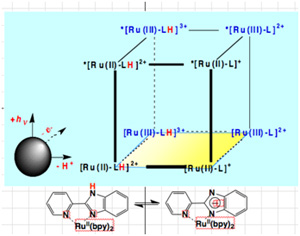
Figure 1: Thermodynamic cubic scheme involving [Ru(bpy)2(PBImH)]2+ electrons, protons, and light. A new chemical species is generated in response to electrons, protons, and light.
In the periodic table of the elements, ruthenium is a transition element which is positioned between iron and osmium. Together with platinum, palladium, rhodium, and iridium, ruthenium is a precious metal. In the case of a ruthenium complex [Ru(bpy)2(PBImH)]2+(bpy=2,2’-bipyridine) (structure shown in Figure 1) which has been configured with a ligand known as pyridyl-benzimidazole (PBImH), the ruthenium changes from a +divalent to a +trivalent. This causes an increase in the acidity of the imino N-H proton of the configured benzimidazole and facilitates dissociation. When an iron (II) ion which has been hydrated in water is oxidized and becomes an iron (III) ion, protons are dissociated from the water which had configured to the iron. This facilitates the transformation to iron hydroxide (II) and results in sediment of a rusty iron color. By increasing the oxidation number of central metal ions, this phenomenon is similar to how the acidity of ligands increases when the electric charge of ligands is drawn to central metal for which the positive electric charge has increased. However, when [Ru(bpy)2(PBImH)]2+ is irradiated with visible light, light emissions with extremely large wavelengths are shown around 650 nm. Nevertheless, when the N-H of the ligands for this complex is deprotonated, the intensity of the light emission decreases dramatically. In this way, in the case of this ruthenium complex, electrons, protons and light move in cooperation. As shown in Figure 1, new chemical species are generated by the stimuli of electrons, protons, and light, and the species exert functionality. For example, Figure 2 shows two ruthenium complexes which were formed from bis (pyridyl-benzimidazole) to which pyridyl-benzimidazole had been connected. The interaction between Ru-Ru changes significantly depending on whether or not protons exist. Analysis of the intervalence charge transfer (IVCT) among photo-induced atoms when the oxidation count for the two ruthenium is in a differing Ru2+-Ru3+ mixed atomic state shows that deprotonating the bridging ligand causes the intensity of the IVCT band to increase and the interaction between Ru-Ru to heighten2). The movement of protons and the movement of electrons are associated a cause a change in physical properties. In this way, by introducing a solution system into a solid system, it is possible to create devices from the functions of molecules which involve electrons and light.
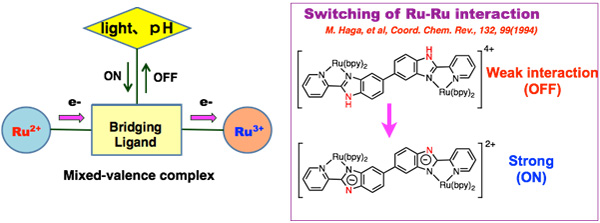
Figure 2: Switching of ruthenium interaction due to protonating/deprotonating of the bridging ligand inside of the ruthenium mixed-valence dinuclear complex.3)
Nano chemistry for molecular building blocks on the surface
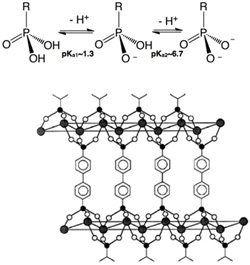
Figure 3: Proton dissociation equilibrium and pKa value for organic phosphonic acid R-P(O)(OH)2, and the structure of the two-dimensional layered crystal which is generated from diphenyl bisphosphonate and zirconium (IV).
Organic phosphonic acid possesses the chemical formula R-P(O)(OH)2 (R=organic group). As shown in Figure 3, it is a dibasic acid capable of dissociating two protons in water. The protons are dissociated and it becomes organic phosphonate [R-P(O)(O)2]2-. When a variety of metal ions are added to a water solution in which organic phosphonate has been dissolved, it is easy to create insoluble sediment. The organic bisphosphonic acid which possesses phosphonic acid groups on both sides of the organic group disassociates, and both sides undergo ionization to become bisphosphonate. This bisphosphonate forms a crystalline solid which has a two-dimensional layered structure which serves as a bridge between metal ions. (Figure 3)
My research group utilized how compounds which possess this phosphonic acid group selectively adhere to the surfaces of a variety of oxidized objects. First, we solidified a primer layer on the surface of complexes which possess side chains of the phosphonic acid group. Then, we created a new functional nano-structure on top of the primer layer through a method which uses the complexation of metal ions to create a regular layered structure. In recent years, various groups throughout the world have begun conducting research on using layered structure construction methods realized through successive complexation as a method for constructing precisely-controlled surface structures. The research conducted by my group is notable for two points: 1) we use redox activation complexes in the molecular unit, and 2) we control the orientation of molecules on the surface by adhering multiple organic groups which are secured to the surface. This nano-structure manufacturing method (also known as Layer-by-Layer or LbL) is easily manufactured by dipping a substrate into solution. Furthermore, through the successive use of different molecules, it is possible to change the sequence and create a variety of combinations. This has enabled us to perform chemistry which uses “molecular building blocks” similar to molecular Lego blocks on the solid surfaces. (Figure 4)

Figure 4: Oxide substrates such as ITO, sapphire and quartz are dipped into a complex solution (3 hours) and then dipped into a zirconium (IV) solution. After washing, they are once again dipped into a complex solution. By repeating these procedures, it is possible to create a multi-layer complex molecular membrane.
Another method for creating a layered membrane is the Langmuir-Blodgett (LB) technique, which uses an air-water interface. By utilizing the property in which amphipathic molecules are oriented on an air-water interface, this technique transcribes the molecules onto a substrate at a certain surface pressure by utilizing surface area-surface pressure isotherms. My research group recognized that titanium oxide nano-sheet colloids (chemically stripped by researchers led by Dr. Takayoshi Sasaki of the National Institute for Materials Science) possess amphiphilicity and transcribe to substrates when surface pressure is applied. We then discovered a method for arranging single-layer nano-sheets which possess an irregular shape onto the surface of solids with almost no gaps (Figure 5).4) This discovery was made by coincidence when Dr. Kezhi Wang (previously stationed at Chuo University as a JSPS Doctoral Researcher; currently a Professor at Beijing Normal University) was washing an LB trough. Today, many researchers use this method to create single-layer membrane on nano-sheets. In addition to molecules which are nano-size building blocks, inorganic nano-sheets and nano-particles are also promising Lego blocks.
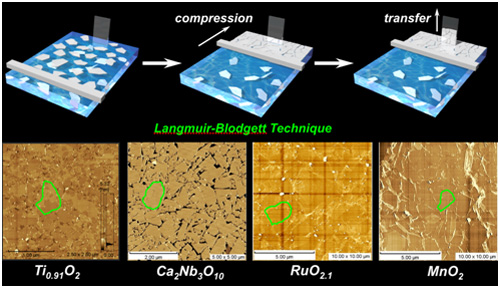
Figure 5: At an LB trough which contained nano-sheet colloid aqueous solution, it is possible to gather amphiphilical nano-sheets when moving the divider on top of the surface to cause compression. This makes transcription possible as a membrane on the substrate at specified surface pressure. This figure shows a conceptual diagram for creating LB membrane, as well as AFM images4) of the titanium oxide, niobate oxide, ruthenium oxide, and manganese oxide which were transcribed onto the silicon substrate.
Controlling the flow of electrons
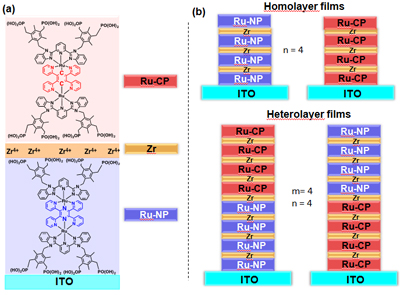
Figure 6: Model diagram for the structure of homolayer membranes and heterolayer membranes created by using two types of ruthenium dinuclear complexes (Ru-NP and Ru-CP) as molecular building blocks, and by using zirconium ions as glue.5)
The flow of electrons is often compared to the flow of water. In order to make water flow, it is necessary to use a sloped conduit or to apply pressure. Furthermore, by creating a sluice, it is possible to store water as a reservoir or dam. In order to draw water from the sluice, a hole is opened in the sluice to enable free use of water. In the same way, in order to induce electrons to flow in a certain direction, it is sufficient to align molecules which possess different electric potential and have been equipped with regular potential gradient. In order to create this gradient, my research group synthesized several complexes with tuned oxide reduction potential (note: called redux potential and expresses the potential energy of electrons) by changing the types of ligand atoms coordinating in ruthenium. We then used the aforementioned LbL method to determine the molecular sequence and crated layered membrane with different potential gradient. Rectifying devices possessing molecules with potential gradient were theoretically predicted as the basic structural element of molecular devices in the 1970s. Afterwards, measurement was performing using molecular membrane. As shown in Figure 6, my research group used to ruthenium complexes to create a hetero-junction molecular membrane. The difference between the two dinuclear complexes Ru-NP and Ru-CP is that the bridging group for Ru-NP is a pyridine group made from nitrogen atoms, while the bridging group for Ru-CP is a benzene group made from carbon atoms. Furthermore, the oxidation potential of the latter is lower by about 0.7 V. By utilizing these two complex molecular units Ru-NP and Ru-CP, we created a variety of hetero-junction molecular membranes on ITO electrodes. As one such example, when using electrochemical measurement to examine the electron migration of the hetero-junction molecular membrane for ITO||(Ru-NP)n|Zr|(Ru-CP)n, we can see a large gap in between the junction surfaces of Ru(III)-Ru(III)/Ru(II)-Ru(III) for Ru-CP and Ru(III)-Ru(II)/Ru(II)-Ru(II) for Ru-NP. When alternately applying an exceeding potential of -0.5 V and +0.7 V, the IVCT band, which appears characteristically in the Ru(II)-Ru(III) mixed valence condition of the Ru-CP layer at 1,140 nm in the near infrared range, appears at -0.5 V and disappears at +0.7 V. This indicates that Ru-NP in the inner layers blocked the electron migration from outer layer Ru-CP when applying -0.5 V. However, when applying +0.7 V, electrons moved from the Ru-NP inner layer to the ITO electrode and a hole was created. Electrons which had been stored as Ru(II)-Ru(III) in the Ru-CP outer layer move like an avalanche into this Ru-NP hole, and catalytic current is exerted. In other words, ITO||(Ru-NP)n|Zr|(Ru-CP)n shows an orderly rectification in which electrons move in one direction. (Figure 7)
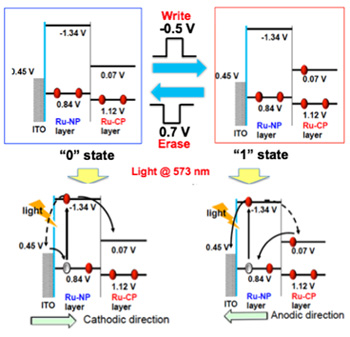
Figure 7: Conceptual diagram (layers grouped and displayed as a single layer) of energy levels for “0” and “1” conditions as caused by pulse electric potential application of the hetero-junction layer membrane ITO (||(Ru-NP)4|Zr|(Ru-CP)4) and occurrence mechanism of photocurrent caused by 573 nm optical irradiation.
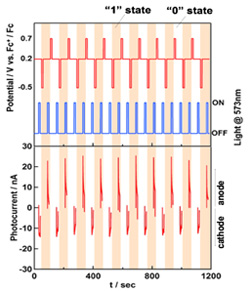
Figure 8: Repetitive pattern of optical illumination and electric potential application to hetero-junction molecular membrane, and the photocurrent response to that pattern (demonstrates that repetition is possible as memory)
This makes it possible to use electric potential application to create two conditions of “0” and “1” for the hetero-junction molecular membrane. These conditions can be detected through near infrared light. In addition, as shown in Figure 8, when performing optical irradiation for the two conditions after the application of -0.5 V and +0.7 V and then measuring the photoelectric current, cathode current was observed in the “0” condition and anode current was observed in the “1” condition. In both cases, the action spectrum of the photoelectric current clearly indicates the involvement of Ru-NP excitement. We have confirmed the existence of a molecular memory function which operates stably even when repeatedly writing to and reading from the device. 5)
In the case of silicon devices, a pn junction is created by performing doping for the silicon, manufacturing p-type and n-type semiconductors, and then connecting them. These devices operate as diodes, solar cells, and optical diodes. In the case of molecules, the orbital energy of molecules is manipulated to connect two molecular layers with different energy states, and the device response is determined by the movement of excited electrons caused by light at the junction layer.
Movement of electrons and protons on the surface of a complex modified carbon nano-tube
Normally, a pH meter is used to measure proton concentration. Specifically, the difference in electric potential between the inside and outside of a thin membrane is measured and then converted into the proton concentration. By skillfully utilizing the collaborative movement of electrons and protons in the complex as introduced above, use as a pH sensor is possible. In the case of complexes where bis (benzimidazole) pyridine has configured to ruthenium, electron movement and proton movement occurs in conjugation, and the RuII/RuIII redux potential shifts toward negative potential as the solution pH rises. When considering the fusion of nano-carbon material and complexes, I believed that this pH dependency of redux potential could be applied to the pH sensor. Next, I focused on how mechanical pencils used in everyday lift are made using graphite which possesses conductivity, and how that graphite could also be used as an electrode for electrochemical measurement. In order to adhere a ruthenium complex which possesses a pyrene base with a bis (benzimidazole) pyridine ligand to a graphite surface, I synthesized a complex which has a large π conjugate system in the side chain (Figure 9). When I adhered this complex to the surface of a mechanical pencil and conducted electrochemical measurement, I found that the RuII/RuIII response changes together with the solution pH, and that the complex serves as a compact pH sensor. In this way, new functionality is imbued in the interface by securing to the surface a complex molecular system with conjugation between electrons and protons. Application to sensors and devices is possible.6)
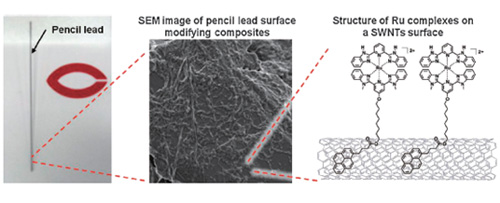
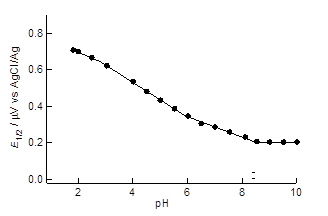
Figure 9: A simple and ultra-compact pH sensor which was created by modifying a ruthenium complex with proton conjugate electron movement into a carbon nano-tube surface and then securing it around the core of a mechanical pencil. A model diagram and the electric potential pH response are also shown.6)
Storage devices which utilize the movement of electrons and protons
In plants, when taking the nano-structure which is affixed to the thylakoid membrane inside of the chloroplast, a large proton concentration gradient occurs inside and outside of the membrane. This proton gradient occurs from the consumption of protons caused by the oxidation and reduction of water. Furthermore, the proton concentration gradient is used to synthesize ATP which is the basis for energy in living organisms. The gradient occurs due to the collaborative movement of electron movement and proton movement in water. I believed that storage could be realized if it were possible to replace the gradient with an electrochemical system and control the movement of electrons and protons. In other words, it realizes storage by converting the pH difference to electric potential difference. Recently, there have been reports of a rocking-chair-type redux super capacitor which operates via an aqueous solution by using the collaborative movement of molecules and proton electrons and using a double-electrode cell in an aqueous solution. A nano-structure for the electrode is also required in this case. In the future, if we are able to develop a storage system which is driven by light (similar to a photosynthesis membrane), it would be possible to create an extremely appealing storage device. I am currently conducting research to realize this goal.
Conclusion
Among the various substances which exist in this world, I have focused my research on metal complexes which mainly possess metal ions. I have researched the functions of metal complexes which are realized through the mutual involvement of electrons, proton, and light. Some examples include electron migration and oxidation-reduction for complexes, collaborative proton migration, light emission, and optically inducted electron migration in an excited state. The interaction of light and metal complexes creates an arena for the performance of electrons and protons. In order to efficiently use light, electrons, and protons to generate new functionality, it is necessary to create nano-structures for complexes which are composed of molecular building blocks.7) I strongly feel the importance of skillful molecular design for creating more opportunities to utilize light, electrons and protons, and the importance of skillful arrangement and orientation. Molecular nano-material possess nano-structure which is precisely controlled based on metal complexes, which are structural units that possess clear geometry. This molecular nano-material is become increasingly important for the creation of new nano-devices and energy conversion elements.
Finally, during many years of research, my discussions with countless outstanding researchers and my laboratory work with associate professors, postdoctoral students, graduate students, and undergraduate students has encouraged my experiments and enable me to realize new results. Through in-depth review of daily research results, the contributions of these individuals paved the road for sowing the seeds of new research and creating “Something New.” For this I am extremely grateful.
1) G. Sprintschnik, et al., J. Am. Chem. Soc., 98, 2337 (1976) (There have been reports that the results of this thesis could not be replicated in subsequent experiments. However, this experiment was a major trigger in conducting research on the photo-dissociation of water using visible light.)
2) M. Haga, et al, Coord. Chem. Rev., 132, 99 (1994)
3) M. Haga, et al., Inorg. Chem., 30, 3843 (1991)
4) M. Muramatsu, et. al., Langmuir 21, 6590(2005)
5) T. Nagashima, et al., Chem. Eur. J, 22, 1658 (2016)
6) H. Ozawa et al., Chem. Lett., 42, 1059(2013)
7) Masaaki Haga “New Developments in Interface Molecular Science” (edited by The Chemical Society of Japan) (Kagukudojin), Chap. 4, pp. 78-86 (2011).
- Masaaki Haga
Professor, Department of Applied Chemistry, Faculty of Science and Engineering, Chuo University
Areas of Specialization: Coordination Chemistry, Molecular Electrochemistry, Surface Chemistry, Nano-Molecular Chemistry - Haga was born in 1950. He graduated from the School of Engineering, Osaka University in 1972. In 1977, he completed the Doctoral Program in the Graduate School of Engineering, Osaka University. From 1978 to 1990, he served as a research assistant, full-time instructor, and assistant professor in the Faculty of Education, Mie University. In 1991, he was appointed as professor in the Faculty of Education, Mie University. In 1996, he was appointed as professor in the Fluid Division of the Coordination Chemistry Laboratories, Institute for Molecular Science. In 1998, he assumed his current position as professor in the Department of Applied Chemistry, Chuo University Faculty of Science and Engineering.
In concurrence with the positions listed above, Haga served as a postdoctoral researcher at York University (Canada) in 1983, as a Gordon Research Fellow at Deakin University (Australia) in 1985, a visiting professor (short-term) at the Pennsylvania State University (America) in 1995, and a visiting professor at Cornell University (America) in 2010. Also he was invited to give lectures at the University of Rennes (France) in 2013 and Beijing Normal University in 2015.
Haga has won awards including the BCSJ Best Paper Award in 2006 and the Fellow Award of American Association for the Advancement of Science (AAAS) in 2015.
His major written works include Complex/Organic Metal Chemistry (co-written; Maruzen Publishing) and Electron Migration in Metal Complexes and Electrochemistry (co-written; Sankyo Shuppan) and more.
- Research Activities as a Member of Research Fellowship for Young Scientists (DC1), Japan Society for the Promotion of Science (JSPS) Shuma Tsurumi
- Important Factors for Innovation in Payment Services Nobuhiko Sugiura
- Beyond the Concepts of Fellow Citizens and Foreigners— To Achieve SDGs Goal 10 “Reduce Inequality Within and Among Countries” Rika Lee
- Diary of Struggles in Cambodia Fumie Fukuoka
- How Can We Measure Learning Ability?
—Analysis of a Competency Self-Assessment Questionnaire— Yu Saito / Yoko Neha - The Making of the Movie Kirakira Megane









